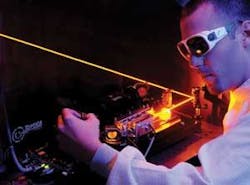ASTRONOMY: Sodium guidestar laser uses fiber Raman technology

Large ground-based telescopes can use a sodium “guidestar” to enable active compensation of atmospheric disturbances using adaptive optics and making possible high-resolution ground-based astronomical observations. A guidestar is created by excitation of the atmospheric sodium layer (D2 line) using a powerful 589 nm laser to generate strong resonance fluorescence.
Existing laser guidestar systems are typically cumbersome and based on dye lasers or sum-frequency systems. At the Laser, World of Photonics event in Munich last month, Toptica Photonics (Graefelfing, Germany) and MPB Communications (Montreal, Canada) showcased a novel guidestar laser based on the European Southern Observatory's narrowband fiber Raman laser technology. The partners’ design delivers more than 20 W single-mode output at 589 nm. “Our approach holds the promise that the output power can be extended well beyond 20 W, to a level that the next-generation telescopes may require,” says Toptica’s President Wilhelm Kaenders.
About the Author
Stephen G. Anderson
Director, Industry Development - SPIE
Stephen Anderson is a photonics industry expert with an international background and has been actively involved with lasers and photonics for more than 30 years. As Director, Industry Development at SPIE – The international society for optics and photonics – he is responsible for tracking the photonics industry markets and technology to help define long-term strategy, while also facilitating development of SPIE’s industry activities. Before joining SPIE, Anderson was Associate Publisher and Editor in Chief of Laser Focus World and chaired the Lasers & Photonics Marketplace Seminar. Anderson also co-founded the BioOptics World brand. Anderson holds a chemistry degree from the University of York and an Executive MBA from Golden Gate University.